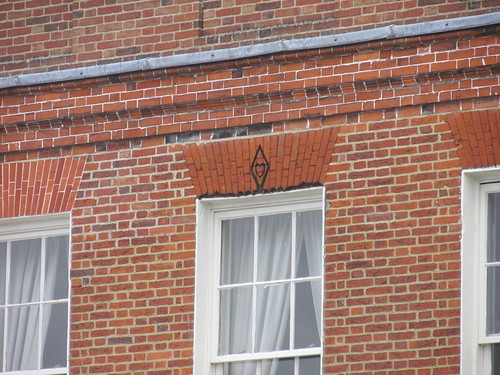As I promised I have just one more tale to tell you of Kings Lynn. One of the main squares in the town is the Tuesday Market Place (There's a Saturday Market Place too.) and the boundaries of the square feature some attractive old buildings. On the north side is a large red brick house with segmental arches above its windows. On the keystone above one window is a carved diamond with a heart at its centre. The mark is known as the witch's heart.
In 1590 townswoman Margaret Read was accused of witchcraft and sentenced to be burned at the stake in the public execution space at the Tuesday Market Place. She protested her innocence, but to no avail, and the execution was carried out as ordered by the court. She swore she would be avenged against her accusers, and on the morning of her death, just as the flames reached her chest, her heart burst through her ribs and marked the house of the Chief Magistrate who had condemned her.
There is, of course, one significant flaw in this story. Witches in Britain were rarely burned at the stake, in spite of all the stories you've been told. They were hanged.
Showing posts with label Kings Lynn. Show all posts
Showing posts with label Kings Lynn. Show all posts
Friday, 22 January 2016
Sunday, 17 January 2016
Hanseatic
The town of Kings Lynn in Norfolk was part of the Hanseatic League, a powerful association of merchants from Northern Germany, the Baltic countries, and those around the North Sea, which operated from the 14th to the early 19th century. By belonging to a trade association such as the League, merchants benefited greatly. It protected economic interests and offered diplomatic privileges to its members.
It is believed to have its early origins in the German town of Lübeck, which was captured by Henry, Duke of Saxony in 1158. Under his rule the town quickly gained dominance of the international trade around the Baltic and became a centre for merchants from around the area. The area's economic strength was built on products such as wax, amber, resin, furs and timber. The League was officially launched in 1356. Towns in the league raised their own armies and were required to come to each other's aid in times of threat.
In spite of the extent of the Hanseatic League at its height (including Bristol, Boston Lincolnshire, Hull, Ipswich, Norwich and Yarmouth) there is only one remaining original Hanseatic warehouse in Europe, and that's in King's Lynn. Walking around the old town it's not difficult to imagine what the port was like in its heyday.
I was lucky enough to live in Kings Lynn old town some years ago. Very close to where these photos were taken - even closer to the photo in my previous post. There's much more to the town than I've told you about here, but I'm not going to bore you with it all. There's just one more story to tell you. Watch this space.
 |
| Part of the old town |
 |
| Kings Lynn's Hanseatic Warehouse |
I was lucky enough to live in Kings Lynn old town some years ago. Very close to where these photos were taken - even closer to the photo in my previous post. There's much more to the town than I've told you about here, but I'm not going to bore you with it all. There's just one more story to tell you. Watch this space.
Monday, 11 January 2016
Captain Vancouver
 |
| Captain Vancouver on Purfleet Quay, Kings Lynn |
As well as naming the Canadian city of Vancouver after himself, he gave other landmarks names of his crew, including Mount Baker, Puget Sound, Mount Hood and Mount Rainier.
However, his travels did not make him popular with everyone. Crewman Thomas Pitt, 2nd Baron Camelford took offence after being disciplined for various infractions of Navy rules. When he returned home he persuaded his cousin William - who just happened to be Prime Minister - to help him bring Vancouver into dishonour. But Prime Minister Pitt (the younger) did not succeed fast enough for sailor Pitt, who challenged his former captain to a duel.
Vancouver refused to take part in a dual to answer for his actions as a serving naval officer so Pitt eventually attacked him in the street. Both were accompanied by friends and an unseemly brawl ensued, which led to a fight in the press, as both sides accused the other of being the instigator, among other crimes. The stress proved too much for Vancouver, who died aged only 40, worn out from his naval service and the legal battles.
Subscribe to:
Posts (Atom)

